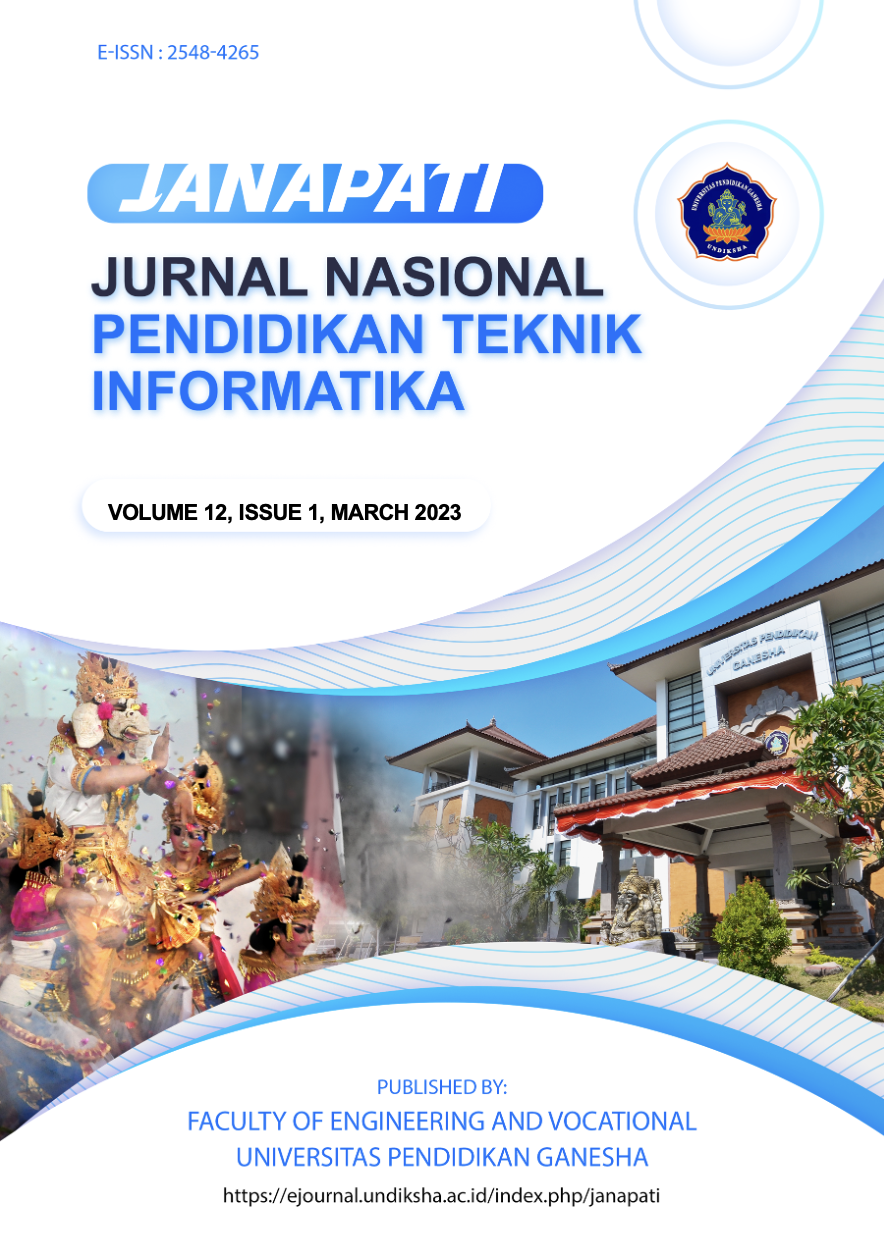Mobilenet-based Transfer Learning for Detection of Eucalyptus Pellita Diseases
DOI:
https://doi.org/10.23887/janapati.v12i1.53220Keywords:
Pulp Industry, deep learning, transfer learning, mobilenet, Eucalyptus PellitaAbstract
Currently, the pulp industry in Indonesia is ranked eighth in the world and the paper industry is ranked sixth in the world. One of the advantages in supporting the industry is that Indonesia has a large Industrial Plantation Forest (HTI) where the plants for pulp and paper raw materials originate. Eucalyptus pellita species belonging to the Myrtaceae family is one of the priority species for Industrial Plantation Forests (HTI) because of its adaptability and its wood can be used as raw material for pulp. Industrial Plantation Forests of this type can be found mainly in Kalimantan and Sumatra. This species shows good growth in stem shape, growth speed and good wood quality and has high germination and has a shorter cutting cycle of about 7-8 years so that it is quickly harvested. Prevention and treatment of leaf disease is one of the main processes of planting. Early diagnosis and accurate recognition of Eucalyptus Pellita disease can control the spread of the disease and reduce production costs and treatment costs. Disease detection on Eucalyptus pellita leaves can be done automatically faster by utilizing digital image processing and artificial intelligence. In this study, we propose a detection method with Deep Learning architecture. Our proposed method is based on pre-trained transfer learning using MobileNet. Image datasets from PT. Surya Hutani Jaya's land in East Kalimantan were used to train the model. The dataset is divided into three classes where 1 class is healthy leaves and 2 classes are sick leaves, namely Xanthomonas Bacteria and Cylindrocladium Fungi. With a dataset ratio of 70: 20: 10 the number of training datasets is 2370, validation is 591, and Testing is 177. Hyperparameter scenarios were carried out on the MobileNet model to optimize performance on the Eucalyptus Pellita leaf dataset. The experimental results show a fairly good accuracy, reaching 98%.
References
M. A. Inail, E. B. Hardiyanto, and D. S. Mendham, “Growth Responses of Eucalyptus pellita F. Muell Plantations in South Sumatra to Macronutrient Fertilisers Following Several Rotations of Acacia mangium Willd.,” Forests, vol. 10, no. 12, p. 1054, Nov. 2019, doi: 10.3390/f10121054.
P. Yudha Adi Putra Wirabuana, R. Sadono, and S. Juniarso, “Planting depth management increases early growth, aboveground biomass, and carbon storage of Eucalyptus pellita at Ultisols in South Sumatra,” J.Degrade.Min.Land Manage., vol. 7, no. 4, pp. 2253–2261, Jul. 2020, doi: 10.15243/jdmlm.2020.074.2253.
AAA Fiber R&D, Y. Yuvika, A. Nasution, AAA Fiber R&D, A. Gafur, and AAA Fiber R&D, “Isolasi dan Penapisan in Vitro Aktinomiset untuk Mengendalikan Xanthomonas,” jfi, vol. 9, no. 5, pp. 160–164, Oct. 2013, doi: 10.14692/jfi.9.5.160.
P. I. R. Dalimunthe, E. B. M. Siregar, and N. Anna, “RESPON CYLINDROCLADIUM SP. TERHADAP FUNGISIDA BERBAHAN AKTIF MANCOZEB SECARA IN VITRO,” p. 11.
Y. Lu, S. Yi, N. Zeng, Y. Liu, and Y. Zhang, “Identification of rice diseases using deep convolutional neural networks,” Neurocomputing, vol. 267, pp. 378–384, Dec. 2017, doi: 10.1016/j.neucom.2017.06.023.
A. Elhassouny and F. Smarandache, “Smart mobile application to recognize tomato leaf diseases using Convolutional Neural Networks,” in 2019 International Conference of Computer Science and Renewable Energies (ICCSRE), Agadir, Morocco, Jul. 2019, pp. 1–4. doi: 10.1109/ICCSRE.2019.8807737.
R. A. Sholihati, I. A. Sulistijono, A. Risnumawan, and E. Kusumawati, “Potato Leaf Disease Classification Using Deep Learning Approach,” in 2020 International Electronics Symposium (IES), Surabaya, Indonesia, Sep. 2020, pp. 392–397. doi: 10.1109/IES50839.2020.9231784.
M. I. Rosadi and M. Lutfi, “Identifikasi Jenis Penyakit Daun Jagung Menggunakan Deep Learning Pre- Trained Model,” p. 8, 2021.
F. Chollet, Deep learning with Python. Shelter Island, New York: Manning Publications Co, 2018.
S. Savalia and V. Emamian, “Cardiac Arrhythmia Classification by Multi-Layer Perceptron and Convolution Neural Networks,” Bioengineering, vol. 5, no. 2, p. 35, May 2018, doi: 10.3390/bioengineering5020035.
Department of Information Technology, Pyay Technological University, Y. M. Oo, N. C. Htun, and Department of Information Technology, Pyay Technological University, “Plant Leaf Disease Detection and Classification using Image Processing,” IJRE, vol. 5, no. 9, pp. 516–523, Nov. 2018, doi: 10.21276/ijre.2018.5.9.4.
A. A. Jaelani and D. F. Y. Supratman, “PERANCANGAN APLIKASI UNTUK KLASIFIKASI KLON DAUN TEH SERI GAMBUNG (GMB) MENGGUNAKAN ALGORITMA CONVOLUTIONAL NEURAL NETWORK,” p. 9.
W. Sae-Lim, W. Wettayaprasit, and P. Aiyarak, “Convolutional Neural Networks Using MobileNet for Skin Lesion Classification,” in 2019 16th International Joint Conference on Computer Science and Software Engineering (JCSSE), Chonburi, Thailand, Jul. 2019, pp. 242–247. doi: 10.1109/JCSSE.2019.8864155.
P. Enkvetchakul and O. Surinta, “Effective Data Augmentation and Training Techniques for Improving Deep Learning in Plant Leaf Disease Recognition,” j.asep, Jan. 2021, doi: 10.14416/j.asep.2021.01.003.
M. A. Z. Foeady, “Automated Diagnosis System of Diabetic Retinopathy Using GLCM Method and SVM Classifier,” p. 7, 2018.
A. G. Howard et al., “MobileNets: Efficient Convolutional Neural Networks for Mobile Vision Applications.” arXiv, Apr. 16, 2017. Accessed: Jul. 28, 2022. [Online]. Available: http://arxiv.org/abs/1704.04861
Downloads
Published
How to Cite
Issue
Section
License
Copyright (c) 2023 Deviana Sely Wita, Agus Subekti

This work is licensed under a Creative Commons Attribution-ShareAlike 4.0 International License.
Authors who publish with Janapati agree to the following terms:- Authors retain copyright and grant the journal the right of first publication with the work simultaneously licensed under a Creative Commons Attribution License (CC BY-SA 4.0) that allows others to share the work with an acknowledgment of the work's authorship and initial publication in this journal
- Authors are able to enter into separate, additional contractual arrangements for the non-exclusive distribution of the journal's published version of the work (e.g., post it to an institutional repository or publish it in a book), with an acknowledgment of its initial publication in this journal.
- Authors are permitted and encouraged to post their work online (e.g., in institutional repositories or on their website) prior to and during the submission process, as it can lead to productive exchanges, as well as earlier and greater citation of published work. (See The Effect of Open Access)







